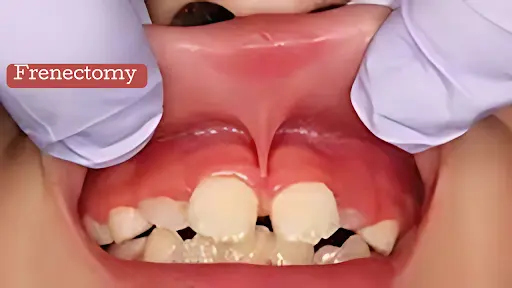This Procedure and its Benefits
Frenectomy is surgery to change or remove a frenulum, the thin band of tissue that connects parts in the mouth. However, many people associate a frenectomy with a child and don’t know that the procedure can be helpful for adults who suffer from speech impediments, gum receding or oral discomfort. In this article, we touch upon why, how, what and how many benefits you can get performed with frenectomy in adults.
What You Need to Know About Frenectomy in Adults
Something known as a frenulum in the oral cavity connects tissues, but is sometimes overly restrictive and located in the wrong place. The two primary frenula addressed in frenectomies include:
- Lingual Frenulum: It’s located beneath the tongue and connects the tongue to the floor of the mouth. Tongue mobility is limited and speech and oral hygiene are affected when it is too tight, leading to tongue tie, or ankyloglossia.
- Labial Frenulum: Situated between the upper or lower lip, and the gums. A restrictive labial frenulum may cause gaps between teeth or gum recession, or may prevent dentures from fitting properly.
Many questions remain about the reason for a Frenectomy as an adult.
Although many frenectomies are performed during childhood, adults may require the procedure for various reasons, including:
- Speech Impairments: It (a tight lingual frenulum) can hinder articulation while speaking.
- Oral Hygiene Challenges: Restricted tongue movement makes difficulty with cleaning.
- Gum Recession: A tight labial frenulum can cause recession and the exposure of tooth roots by pulling on the gums.
- Orthodontic Issues: Frenula are troublesome to orthodontic treatments and may be the cause of teeth failing to align correctly.
- Discomfort with Dentures: Wearing or fitting dentures can be uncomfortable if there is a restrictive frenulum.
Is a Frenectomy Necessary?
Adults experiencing the following symptoms may benefit from a frenectomy:
Informant of speech difficulties that are hard to understand, or unable to pronounce certain sounds over a long period of time.
- Pain or Aches in the Gums or Mouth.
- Large gap in the middle of the teeth in the front of the mouth.
- The inability to effectively clean teeth or dental tools.
- Trouble wearing dentures or orthodontic appliances.
- A frenectomy is best consulted with a dentist or oral surgeon.
There are different types of Frenectomy procedures.
Traditional surgical methods can be used to perform a frenectomy, or, more modern, a laser technique that utilizes a laser fiber to remove the tissue. The patient’s needs and the practitioner’s experience will determine the choice.
The traditional surgical frenectomy.
- Anesthesia: It numbs the area locally.
- Incision: The restrictive frenulum is cut by a scalpel.
- Stitches: The incision may be closed with sutures if needed.
- Recovery: It usually takes 1-2 weeks to heal.
- Laser Frenectomy
- Preparation: Local anesthesia is applied.
- Laser Procedure: The frenulum is cut with a laser very precisely and cauterized.
- No Stitches Required: As they cut, lasers seal the tissue.
- Faster Recovery: It’s often used with patients because it causes less discomfort and healing can be speedier.
Laser frenectomy is desirable because it is precise, produces less bleeding, and quickens recovery time.
There are benefits of Frenectomy for Adults.
Undergoing a frenectomy offers several advantages, including:
- Better speech clarity and ability to articulate.
- It increased tongue mobility and thus improving oral hygiene.
- Preventing gum recession and dental problems that can occur because of it.
- With dentures or other orthodontic devices, a better fit and greater comfort.
- It relieves oral discomfort created by restrictive tissues.
Let’s talk about post procedure care and recovery.
Recovery from a frenectomy is simple, and most people are back to normal life within days. Following these tips ensures a smooth healing process:
- Maintain Oral Hygiene: Prevent infection by gently cleaning the mouth.
- Soft Diet: Avoid irritating food with hard consistency by consuming soft foods.
- Pain Management: Take prescribed or over the counter pain relieves accordingly.
- Follow-Up Exercises: There is nothing you need to do other than do the recommended exercises to maintain mobility and prevent scar tissue.
- Regular Check-Ups: Visit follow up appointments to check on healing.
Risks and Considerations
While frenectomy is a safe procedure, potential risks include:
1. Minor bleeding or swelling.
Discomfort in the treated area, but it should be temporary.
2. Formation of scar tissue.
Although rare, they may recur in restrictive tissue.
Loudening a voice is better done with a qualified oral surgeon.
3. When to Consult a Specialist
If adults exhibit persistent oral discomfort, speech issues or have dental issues they should see an oral health specialist. Intervention early can prevent complications and will keep overall oral function and comfort at their best.
Conclusion
Adults with restrictive frenula will find frenectomy a beneficial procedure. Whichever the case, this minor surgery can make a huge difference in your quality of life by improving speech, managing teeth and enhancing comfort. With the help from an experienced oral surgeon, adults can talk about whether a frenectomy is the correct avenue for them.


